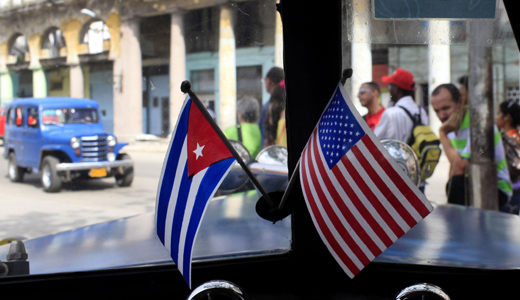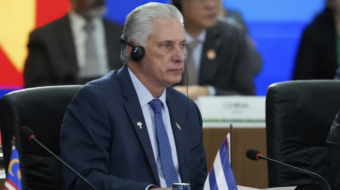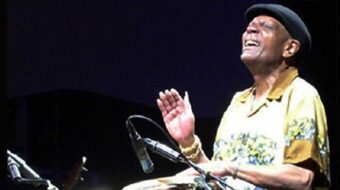
The New York Times first engaged with the Cuban Revolution in late 1956, when Times reporter Herbert Matthews hiked into Cuba’s Sierra Maestra Mountains to interview insurgent leader Fidel Castro. Most recently, on Oct. 12, the Times called upon President Obama to “End the Embargo on Cuba.”
Commenting a day later, Fidel Castro, retired now after serving as Cuba’s President, asks, “[W]hy doesn’t it [the Times] mention this straight away, that in no way is this society comparable to that which Harry S. Truman bequeathed to us when his ally and great public treasury looter Fulgencio Batista took power on March 10, 1952… This can never be forgotten.“
Castro read the editorial as “seeking the greatest benefit for U.S. policy in a complex situation, in the midst of increasing political, economic, financial and commercial problems.” He recalled his encounter 56 years ago with Matthews. Quoting from the editorial, he succeeded in communicating its actual content to Cuban readers.
For the Times, it’s now “politically feasible to re-establish formal diplomatic relations and dismantle the senseless embargo.” The Times sees Cuban Americans registering opposition to blockade policies and their older and more intransigent elders disappearing. Cuban trade with powers like China and Russia clearly worries the newspaper. “The embargo was an utter failure,” the editors admit, presumably reflecting on the Cuban Revolution’s continued survival.
The New York Times wants Cuba off the U.S. list of nations that sponsor terrorism, and it hopes that ending the blockade will improve U.S. relations with Latin America. The editorial envisions adjustments like U. S. corporations “developing the island’s telecommunications network,” U.S. financing of “private Cuban businesses,” and allowing Cuban Americans to send more money to relatives on the island. The newspaper wants U.S. travel to the island opened up.
José Manzaneda, Cubainformación news service coordinator, believes improving the trade competitiveness of some U.S. companies is the main U.S. motive for ending economic sanctions. One editorial suggestion particularly concerns him, the idea that with the blockade gone there “would [be] opportunities to empower ordinary Cubans, gradually eroding the government’s ability to control their lives.” There lies the potential, he says, for “naming dissidents” [to be] sustained by the United States.”
Although the editorial is “one step more along the right road,” it ultimately wants to replace “Cuban social democracy” with “a model of neo-colonial capitalism subjected to the interests of the United States.”
Many critics of U.S. policies have already set forth particular objections to the blockade that are ignored in the editorial, for example, the blockade’s cruelty, illegality, and even immorality; international disapproval registered through UN General Assembly resolutions; and continuing imprisonment of three of the Cuban Five political prisoners.
The editorial allows as how, “Fully ending the embargo will require Congress’s approval.” Indeed, legislation remains in force subjecting third-country corporations to U.S. penalties if they export goods to Cuba that contain U.S. components or were produced with U.S. financing. According to U.S. law, ships calling at Cuban ports may not dock in the United States for the following six months. And humanitarian agencies and third-country financial institutions dealing with Cuba regularly face U.S. sanctions if they handle U.S. dollars.
The Times wonders if a U.S. opening to Cuba might not lead to U.S. citizen Alan Gross’s release from a Cuban jail. The U.S. Agency for International Development (USAID) had funded Gross’s delivery of high-technology communications equipment to private citizens in Cuba, a known illegal activity. That’s maybe why the newspaper identifies him as “an American development contractor.” It gets low marks for fact-checking.
USAID actually funded Developmental Alternatives Inc. (DAI) to pay and supply Gross. A redacted copy of DAI’s proposal to USAID for launching an anti-Cuban subversion program involving Gross appeared recently on reporter Tracey Eaton’s website. DAI’s mission, and so too with Gross, was “to facilitate a democratic transition in Cuba through targeted support to Cuban civil society [and] to bolster the effectiveness of independent voices within Cuba.
Overall, and unsurprisingly, the New York Times takes on the U.S. blockade in piecemeal fashion. Any demand for Congress to act, for example, is not on the agenda.
Reporter Herbert Matthews had a hand in some of that reluctance. In early 1957 he gave the lie to the Batista dictatorship by revealing that Fidel Castro was still alive. He indicated Castro’s small force was making gains and that Batista’s army was in trouble. Then with the victory of the Revolution two years later and the continuing sway of U.S. anti-communism, criticism emerged of Matthew’s favorable reporting on the guerrillas and his subsequent association with the newspaper. Caution on Cuba became the rule thereafter for the New York Times.
Photo: Franklin Reyes/AP










